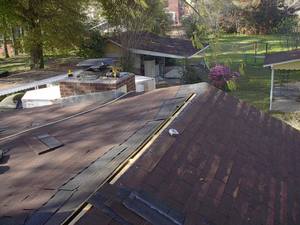This time last year, 2008 seemed so far away. In fact, who was concerned about 2008, because this time last year we had just begun 2007. But now a new year is here, and for many people, it is a time of reflection, of resolution and for planning. Unfortunately, for the homeowner and income earner, it is a time for filing income taxes, getting one’s return and then deciding on which home improvement projects to spend said return. Furthermore, if you are a taxpayer who gets a hefty return, you may be looking at replacing the shingles on the roof of your home.
Every twenty years or so a house’s shingles have succumbed to age and the elements. Many of the shingles on your home may have faded in color or lost many of the granules that make up their rough, sandpaper surface. In windy parts of the country some of your shingles may have come loose and been blown away by the wind leaving a gaping black rectangular hole in your roofing. Or perhaps you have the unfortunate lot of being one of those who have had a leak develop, a leak which is not dripping into your house through the ceiling. So needless to say many will be re-shingling your homes. Whether you do it yourself or you hire a contractor be sure that good quality materials and procedures are used to ensure that you get the most out of your newly shingled roof.
Of course maintenance plays greatly into the longevity of your new roof. For the most parts shingles require no maintenance but there are certain circumstances under which you will need to take some extra steps and precautions to guarantee that the next twenty years of living under your new roof are trouble-free.
The first step is to keep the roof clear of leaves and other debris. If the location of your house is like mine then you may have many large trees around your property. I have two large oak trees whose massive upper branches are suspended directly above my roof over a large roof valley. This particular valley on my roof is important because several other valleys lead into thus when it rains this key valley receives much of the run-off from other parts of the roof. Now the aforementioned oak trees seem to take great pleasure in the one pastime afforded to trees: dropping leaves and acorns. This autumn, those two leaved giants rained a shower of leaves and acorns on my roof that all but covered this all important valley on my roof. Basically it formed a kind of dam that built up water until finally, during the most recent storm, my roof leaked and I had water dripping into my den. It took only half an hours to take a leaf blower and a push broom up to the roof and clear off the bed of leaves. I could see where water had built up. Now the area is completely clear and I am ready for the next rain. If you have large trees this may be a year-round task that you will have to add to your to-do list but it is minor compared to the damage water can do to your ceiling and anything else leaking water may come into contact. So rule #1 is keep your roof clear of debris.
Rule #2 is not quite as simple but it also need not be performed as often. In fact you only need to invoke rule #2 when needed. It involves replacing loose shingles. Whenever wind loosens a shingle it is not only unsightly but it puts you in danger of having a major leak on your hands. With a loose shingle the only thing that stands between the elements and the interior of your home or attic is a relatively then piece of tar paper that will not stand up long against heavy rain. When you first replace your shingles, do yourself a favor and buy an extra bundle or so to keep around for such an occasion. It should be pretty easy to loosen nearby shingles and slip in the replacement shingle and then nail it all back down again. Do it carefully and no one will be able to tell that the replacement shingle had not been there all the time!
Finally you should monthly do a full check-up on your roof and shingles. By this I mean take some time to get on top of your roof and look closely at the shingles, the valleys, the flashing, and any other key spots and look for potential problems. You can save yourself some money, work and headache later by catching minor problems while they are still minor. If your locale goes through a particularly rainy part of the year you may do these check-ups even more frequently than I have suggested here. In any case make sure you stay up-to-date on the overall health of your roof. And it is always a good idea to keep a supply of tar, flashing, extra shingles, nails and other tools of the trade in case you have to do some repairs.
As with anything the key to keeping your roof lasting as long as it possibly can is to roof it right to begin with. Make sure you use good quality products and/or a reputable roofing company. But beyond that make sure that as you are mowing your lawn and cleaning out the gutters that you set aside time for doing maintenance and check-ups on your new roof.
I hope this helps you and if you plan on re-roofing your house this year, good luck!



